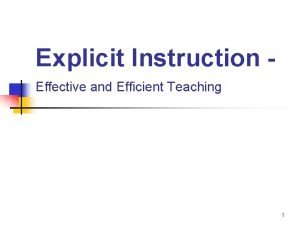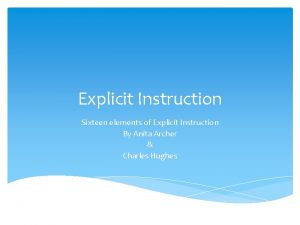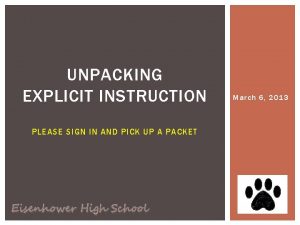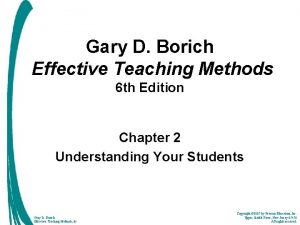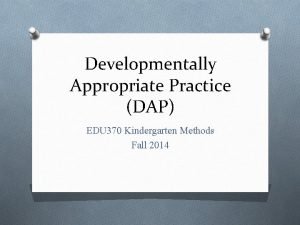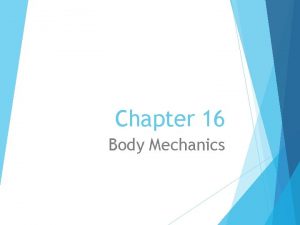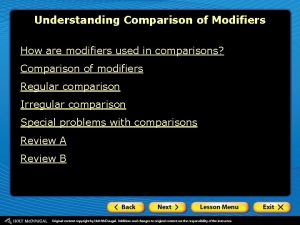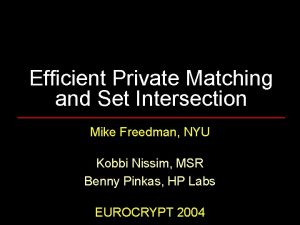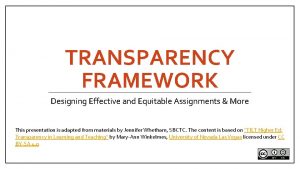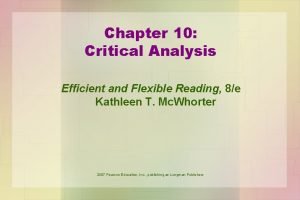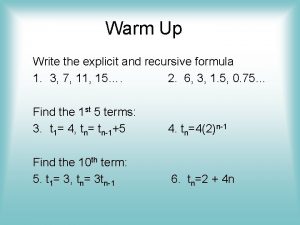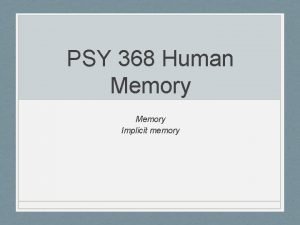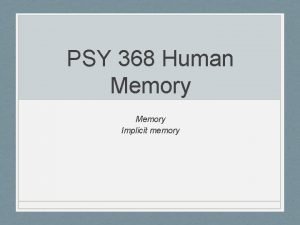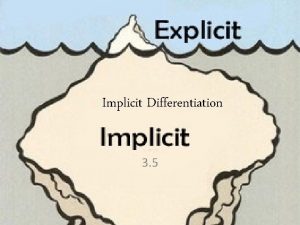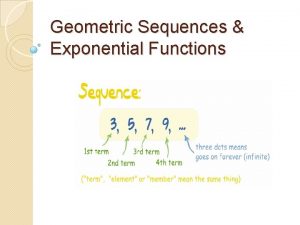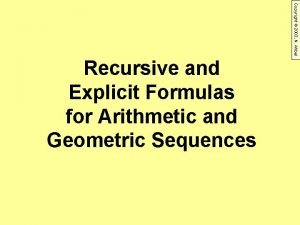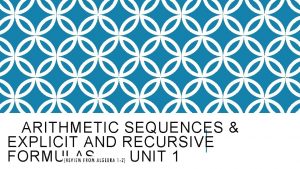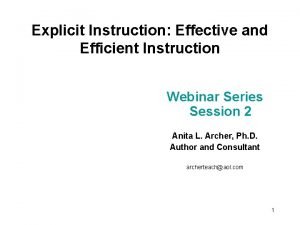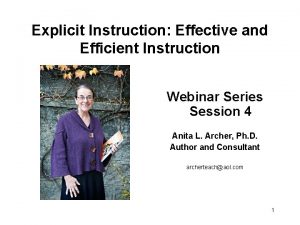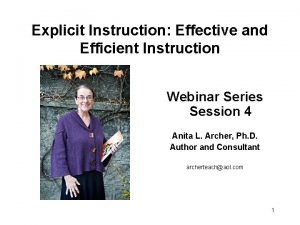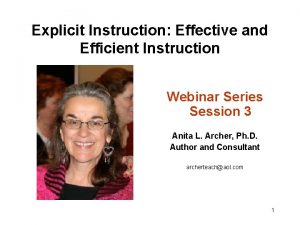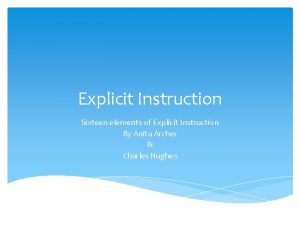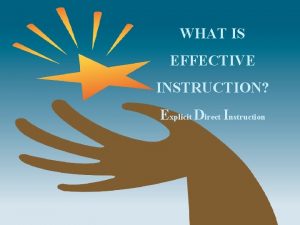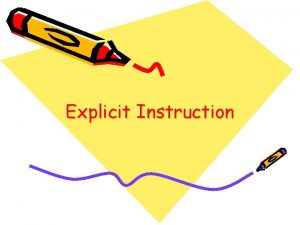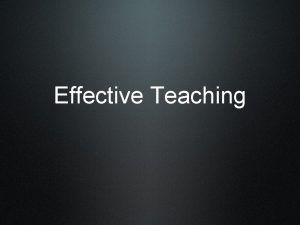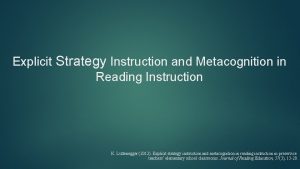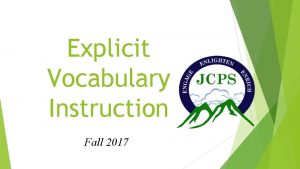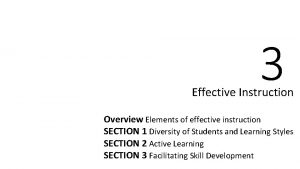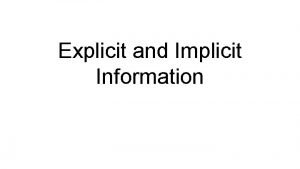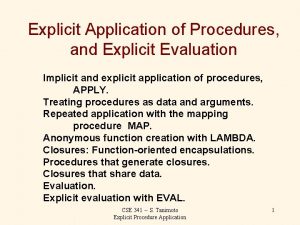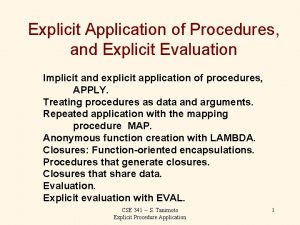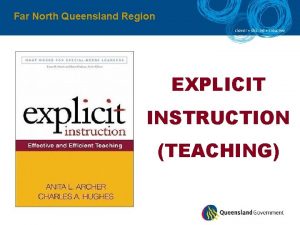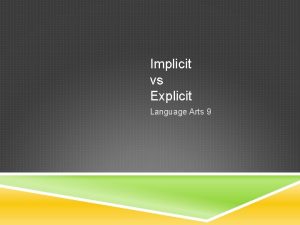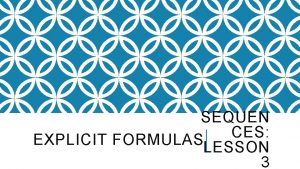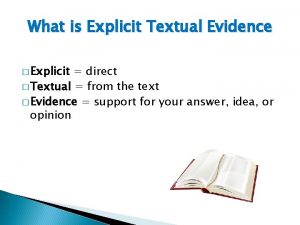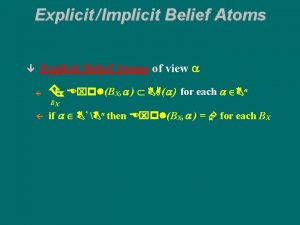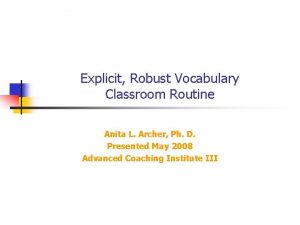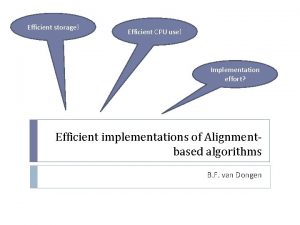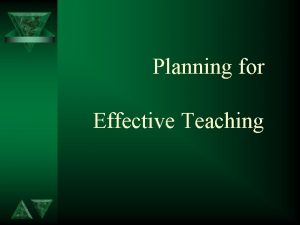Explicit Instruction Effective and Efficient Teaching 1 Anita




































- Slides: 36

Explicit Instruction Effective and Efficient Teaching 1

Anita L. Archer, Ph. D. archerteach@aol. com 503 -295 -7749 (Note: This presentation is based on the research summarized in the following book. ) Archer, A. , & Hughes, C. (2011). Explicit Instruction: Effective and Efficient Teaching. NY: Guilford Publications. www. explicitinstruction. org 2

What is Explicit Instruction? n Explicit instruction is a systematic instructional approach that includes a set of delivery and design procedures derived from effective schools research………. Ideas that Work n …unambiguous and direct approach to teaching that incorporates instruction design and delivery. Archer & Hughes, 2011 3

Explicit Instruction and Discovery Not an either or - but a when. Explicit Instruction Discovery Little or no A great deal of background knowledge in the domain History of difficulty, of failure History of success 4

Explicit Instruction is Systematic n. Relentless n. Engaging n 5

Explicit Instruction is n Systematic Content n. Design of Instruction n 6

Explicit Instruction is systematic. Content n Instruction focuses on critical content. Skills, strategies, vocabulary terms, concepts, and rules that will empower students in the future are taught. n Skills, strategies, and concepts are sequenced logically. n n n Easier skills before harder skills. High frequency skills before low frequency skills. Prerequisites first. Similar skills separated. Complex skills and strategies are broken down into smaller (easy to obtain) instruction units. 7

Break down complex skills. Example - Common Core Standards n English Language Arts Standards Writing Grade 5 (Example - Final Outcome Only) Write opinion pieces on topics or texts, supporting a point of view with reasons and information. n n Introduce a topic or text clearly, state an opinion, and create an organizational structure in which ideas are logically grouped to support the writer’s purpose. Provide logically ordered reasons that are supported by facts and details. Link opinion and reasons using words, phrases, and clauses (e. g. , consequently, specifically). Provide a concluding statement or section related to the opinion presented. 8

Break down complex skills. Example - Common Core Standards Body of Opinion Paper Transcription 1. When given a reason and related facts and details, can write a paragraph with a topic sentence stating the reason. 2. When given a reason and related facts and details, can write a paragraph with a topic sentence stating the reason followed by sentences containing facts and details, connected with transition words and phrases. 3. When given three reasons and related facts and details, can write three paragraphs each containing a topic sentence stating the reason followed by sentences containing facts and details, connected with transition words and phrases. Planning 4. When given a position on a topic, can generate reasons to support that position. 5. When given a topic, can generate a position and reasons and details to support that position. 6. When given a topic, can generate a position and reasons to support that position, and details to logically support each reason. 7. When given a topic, can generate a plan for the body of an essay (the position, the reasons, details to support each reason) and transcribe the plan into three coherent paragraphs. 9

Break down complex skills. Example - Common Core Standards Introduction 8. For previously formulated opinion papers, writes an introduction that: a) grabs the attention of the reader, b) states the writer’s opinion, and c) introduces reasons to support the writer’s opinion. Conclusion 9. For previously formulated opinion papers, writes a short conclusion “wraps it up” the essay by: a) summarizing the opinion and reasons, b) calling for some action to be taken, or c) explaining the outcomes of not following the writer’s suggestions. Opinion Papers 10. When given a topic, can plan, write, and edit an opinion paper that includes: a) an effective introduction, b) a well structured body with logically organized reasons and related facts and details, linked with appropriate transition words and phrases, and c) a short conclusion that “wraps it up”. 10

Explicit Instruction is systematic. Design of Instruction Lessons: 1. Are organized and focused lessons. 2. Begin with a statement of goals. 3. Provide review of preskills and knowledge. 4. Provide step-by-step demonstrations. 11

Explicit Instruction is systematic. Design of Instruction 4. Provide guided and supported practice. 5. Use clear and concise language. 12

Explicit Instruction is systematic. Design of Instruction opening attention n review n preview n body closing review n preview n 13

Explicit Instruction is systematic. Design of Instruction Lesson Opening n n n Attention n Use a verbal cue such as “Listen” or “We are going to begin. ” n Follow the verbal cue with silence. Review n Review the content of the previous lessons. n Review necessary preskills for today’s lesson. n Review background knowledge needed for today’s lesson. n Be sure that the review is interactive. Preview n State the goal of the lesson. n Preview the activities for the period. 14

Explicit Instruction is systematic. Design of Instruction Lesson Closing n Review n n n Preview n n Review the skills/strategies/concepts/information taught. Be sure that the review is interactive. Preview the content that will be taught in the next lesson. Independent Work n Review assignments /quizzes/ projects/ performances due in the future. Have students 15 record all assignments.

Explicit Instruction is systematic. Design of Instruction 1. Facts 2. Skills and Strategies (Do) 3. Concepts and Vocabulary (What) 16

Explicit Instruction is systematic. Design of Instruction Explicit Instruction of Skills/Strategies Model I do it. My turn. Prompt We do it. Let’s do this together. Check You do it. Your turn. 17

Explicit Instruction is systematic. Design of Instruction Model (I do it. ) “My Turn. ” n n n Show n Proceed step-by-step. n Exaggerate the steps. Tell n Tell students what you are doing. n Tell students what you are thinking. Gain Responses n What they already know. n Repeating what you tell them. 18

Explicit Instruction is systematic. Design of Instruction n n Prompt (We do it. ) “Let’s do ---together. ” Prompt by doing behavior at the same time. OR n Prompt verbally. n Guide or lead students through the strategy. n Step - do - Step - do n Gradually fade your prompt. 19

Explicit Instruction is systematic. Design of Instruction Check for understanding. (You do it. ) n Verify students’ understanding before independent work is given. n Carefully monitor students’ responses. n Continue until students are consistently accurate. 20

Explicit Instruction is systematic. Design of Instruction Explicit Instruction of Concepts(vocabulary) 1. 2. 3. 4. Introduce the word. Provide a “student-friendly explanation. ” Illustrate with examples. Check understanding. 21

Instructional Routine for Vocabulary Step 1. Introduce the word. a) b) Write the word on the board or overhead. Read the word and have the students repeat the word. If the word is difficult to pronounce or unfamiliar have the students repeat the word a number of times. Introduce the word with me. “ This word is compulsory. What word? ” 22

Instructional Routine for Vocabulary (continued) Step 2. Introduce meaning of word. Option # 1. Present a student-friendly explanation. a) b) Tell students the explanation. OR Have them read the explanation with you. Present the definition with me. “When something is required and you must do it, it is compulsory. So if it is required and you must do it, it is ________. ” 23

Instructional Routine for Vocabulary (continued) Step 2. Introduce meaning of word. Option # 2. Have students locate the definition in the glossary or text. a) b) Have them locate the word in the glossary or text. Have them break the definition into the critical attributes. Glossary Entry: Industrial Revolution Social and economic changes in Great Britain, Europe, and the United States that began around 1750 and resulted from making products in factories Industrial Revolution o o Social & economic changes Great Britain, Europe, US Began around 1750 Resulted from making products in factories 24

Instructional Routine for Vocabulary (continued) Step 2. Introduce meaning of word. Option # 3. Introduce the word using the morphographs in the word. autobiography auto = self hydroelectricity hydro = water 25

Instructional Routine for Vocabulary (continued) Step 3. Illustrate the word with examples. a) b) c) Concrete examples. Visual examples. Verbal examples. (Also discuss when the term might be used and who might use the term. ) Present the examples with me. “Coming to school as 8 th graders is compulsory. ” “Stopping at a stop sign when driving is compulsory. ” 26

Instructional Routine for Vocabulary (Continued) Step 4. Check students’ understanding. Option #1. Ask deep processing questions. Check students’ understanding with me. “Many things become compulsory. Why do you think something would become compulsory? ” 27

Instructional Routine for Vocabulary (continued) Step 4. Check students’ understanding. Option #2. Have students discern between examples and non-examples. Check students’ understanding with me. “Is going to school in 8 th grade compulsory? ” Yes “How do you know it is compulsory? ” It is required. “Is going to college when you are 25 compulsory? ” “Why is it not compulsory? ” It is not required. You get to choose to go to college. 28

Instructional Routine for Vocabulary (continued) Step 4. Check students’ understanding. Option #3. Have students generate their own examples. Check students’ understanding with me. “There are many things at this school that are compulsory? Think of as many things as you can? ” “Talk with your partner. See how many things you can think of that are compulsory. ” 29

Instructional Routine for Vocabulary Did the teacher: 1. Introduce the word? 2. Present a student-friendly explanation? 3. Illustrate the word with examples? 4. Check students’ understanding? 30

Explicit Instruction is n Relentless Practice n n Tier 3 students may require 10 to 30 times as many practice opportunities as peers. 31

Explicit Instruction is relentless. Judicious Practice 1. Initial practice. 2. Distributed practice. 3. Cumulative review. 32

Explicit Instruction is relentless. Judicious Practice Initial Practice n n Occurs under watchful eye of the teacher Provide numerous practice opportunities within the teacher-directed lesson to build accuracy. Provide immediate feedback after each item. 33

Explicit Instruction is relentless. Judicious Practice Distributed Practice n n Studying or practicing a skill in short sessions overtime. Distributing practice overtime (versus massing practice in one session) aids retention in a variety of academic areas. 34

Explicit Instruction is relentless. Judicious Practice Cumulative Review n n Provide intentional review of previously taught skills/strategies/concepts /vocabulary/knowledge. Goal is to increase long-term retention. 35

Explicit Instruction is relentless. Judicious Practice It is not: Drill and Kill It is: Drill and Skill Perhaps: Drill and Thrill 36
 Examples of explicit instruction
Examples of explicit instruction Productively efficient vs allocatively efficient
Productively efficient vs allocatively efficient Allocative efficiency
Allocative efficiency Productively efficient vs allocatively efficient
Productively efficient vs allocatively efficient Productively efficient vs allocatively efficient
Productively efficient vs allocatively efficient Productive inefficiency and allocative inefficiency
Productive inefficiency and allocative inefficiency Effective and efficient example
Effective and efficient example 16 elements of explicit instruction
16 elements of explicit instruction Phonics chapter 6
Phonics chapter 6 Components of explicit instruction
Components of explicit instruction Effective teaching evidence and practice
Effective teaching evidence and practice Differentiated instruction vs individualized instruction
Differentiated instruction vs individualized instruction Direct instruction strategies
Direct instruction strategies Microteaching phases
Microteaching phases Difference
Difference Gary borich
Gary borich 10 principles of effective online teaching
10 principles of effective online teaching Measures of effective teaching project
Measures of effective teaching project Developmentally appropriate practice for kindergarten
Developmentally appropriate practice for kindergarten Scholar and gypsy by anita desai summary
Scholar and gypsy by anita desai summary Using the body in an efficient and careful way is
Using the body in an efficient and careful way is Comparative modifier
Comparative modifier Efficient private matching and set intersection
Efficient private matching and set intersection Efficient capital markets and behavioral challenges
Efficient capital markets and behavioral challenges Efficient and equitable taxation
Efficient and equitable taxation Assignment title examples
Assignment title examples Comparative and superlative efficient
Comparative and superlative efficient Efficient and flexible reading
Efficient and flexible reading Efficient comparative and superlative
Efficient comparative and superlative Difference between explicit and recursive
Difference between explicit and recursive Implicit and explicit memory
Implicit and explicit memory Implicit memory psychology example
Implicit memory psychology example Difference between implicit and explicit memory
Difference between implicit and explicit memory Explicit and implicit functions
Explicit and implicit functions Geometric series exponential
Geometric series exponential Recursive and explicit formula
Recursive and explicit formula Site:slidetodoc.com
Site:slidetodoc.com
